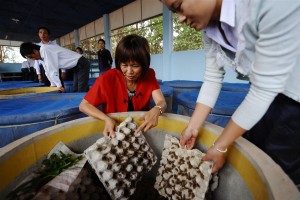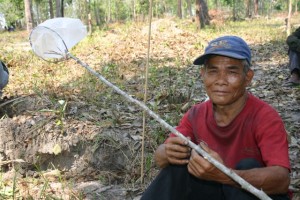To improve nutrition Lao government promotes insect farming and consumption.

Advocates claim that insect farming can provide producers with significant income, and consumers with food that is wholesome and nutritious. Participants in a recent worksop learned the fundamentals of insect nutrition and received "starter kits" that will enable to immediately begin raining insects for personal consumption and sale.
Americans who’ve traveled in Laos will confirm that this is a nation of short people. My best posture, combined with an ambitious, vertebrae-cracking neck-stretch, still leaves me a hair under six feet tall. But, when I stand among residents of a typical Lao village I tower above everyone else- six inches taller than most adults, a full foot taller than many men and women.
The short stature of the Lao people is, no doubt, largely due to genetic factors but nutrition plays a significant role. A 2007 World Food Program (WFP) report estimated that 40 percent of Lao children beginning elementary school are already stunted from malnutrition, one of the worst rates in all of Southeast Asia.
But travelers in Laos don’t need to peruse medical literature to confirm that people here lack proper nutrition. When children bathe next to me in the river or at the village well, I can usually count their every rib; I see shoulder blades protruding from children’s tiny backs like folded angle wings.
One interesting movement gaining traction here is a concerted effort to promote insect farming and consumption. Advocates claim that with proper planning, investment, and consumer education, sustainable insect farming could play a significant role in alleviating chronic malnutrition.
There are about 1,700 edible insect species worldwide but only recently have researchers begun to seriously study their varied nutritional benefits. It’s now known that many species provide an excellent source of protein, fats, carbohydrates, calcium, vitamins and other minerals.
While it takes a fair amount of persuasion (“ I double dog dare you”) to entice the average American to sample any species of insect, at any stage of it’s life cycle, almost all Lao people (one survey pegs the number at 95%) regularly consume insect protein either as a snack or as an ingredient in a more complex recipe.

Lao villagers know the habits of many insect species and take advantage of seasonal events to capture insects while they are at a stage of their life cycle when they are most nutritious and flavorful.
In every corner of Laos, among widely varying ethnic groups, I’ve been offered insects to eat fresh or cooked, as a stand-alone tidbit or as a side dish in a larger meal. And, while working in the countryside, I’ve frequently watched children and adults employ a variety techniques to capture flying, swimming, crawling, or burrowing insects.
Whatever their appearance, whatever mental associations they conjure, this can be said on behalf of the insects as a food source: they are local, abundant, natural, and chemical free.
(Within this blog, see our post for August 3, 2006: “Food From The Sky”.
The Food and Agriculture Organization (FAO) of the United Nations, in collaboration with the Faculty of Agriculture at Lao National University, has begun sponsoring training classes on edible insect farming and recently established the Edible Insect Farming Demonstration Site at the university’s Nabong Campus.
Last March twenty farmers from Vientiane Province received both practical and theoretical training on how to breed cricket, palm weevil, mealworm and weaver ants. They also received instruction on insect marketing and insect nutritional values.
To enable participating farmers to immediately start their own breeding farms all attendees left with kits that included one breeding tank, thirty kilogram of feed, and a starter colony of edible insects.
Three more training courses will held this year, both at the university demonstration site and at various other locations in the provinces. The next session will train additional farmers; the following two sessions will provide “training of trainers” instruction preparing extension officers who will then disseminate their knowledge to others.

I haven’t noticed that eating insects makes me any taller but a bowl of crispy crickets always puts a spring in my step. Hop hop!
LOL!! Can I steal that line and use it when speaking to groups?!!